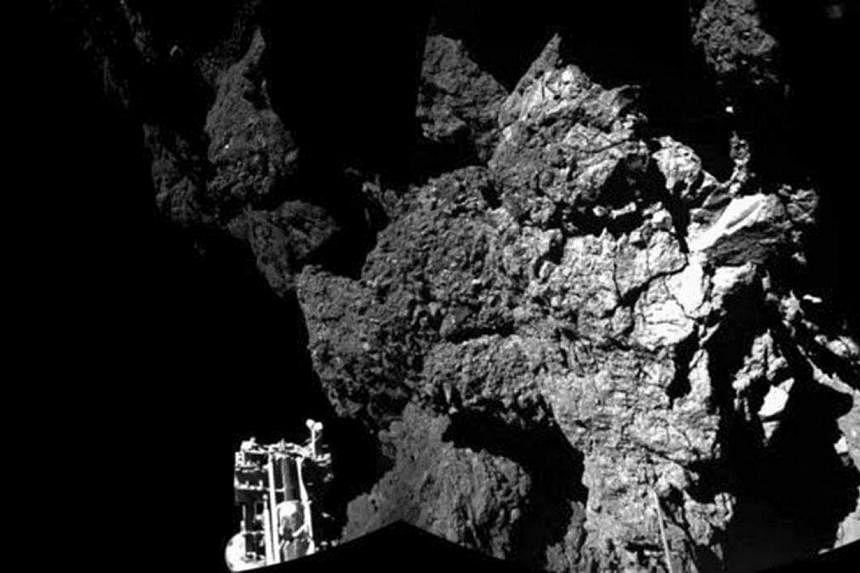While people here go about their everyday lives, an impressive feat has been achieved in space, and it may mean more than you expect. You don't have to be a science geek or an astronomy buff to understand why the latest space effort is a milestone. Just read on.
What is Rosetta, and what is Philae?
Rosetta is a spacecraft that was launched for the Rosetta Mission, along with a robotic probe named Philae, more than a decade ago by the European Space Agency (ESA).
What happened and why does it matter?
On Wednesday, after travelling in space for more than 10 years and clocking up more than six billion kilometres, Philae became the first probe to land on a comet. Philae is now safely attached to the comet named 67P/Churyumov-Gerasimenko. The probe may be able to provide new information on the comet.
According to the ESA website, comets are the oldest, most primitive bodies in the Solar System, preserving the earliest record of material from the nebula out of which our Sun and planets were formed. They remain relatively unchanged through time, compared to planets. Scientists have long debated whether comets provided Earth's first water source.
"Rosetta is trying to answer the very big questions about the history of our solar system. What were the conditions like at its infancy and how did it evolve? What role did comets play in this evolution? How do comets work?" said Matt Taylor, a Rosetta project scientist from ESA.
What is the significance of the names Rosetta and Philae?
According the ESA website, the craft is named after the Rosetta Stone, a slab of volcanic basalt found in Egypt in 1799. By comparing the three carved inscriptions on the stone, historians were able to decipher hieroglyphics - the written language of ancient Egypt, which was then a mystery. Scholars were able to piece together the history of a lost culture.
An explanation from the ESA site says: "The Rosetta Stone provided the key to an ancient civilisation. ESA's Rosetta mission will allow scientists to unlock the mysteries of the oldest building blocks of our solar system: comets."
ESA also said that the probe Philae, also called the lander, is named after an island in the Nile River where an obelisk was found that helped decipher the Rosetta Stone.
What is a comet and how are comets named?
According to the National Aeronautics and Space Administration (NASA) website, comets are leftovers from the dawn of the solar system around 4.6 billion years ago, and consist mostly of ice coated with dark organic material. Comets may have brought water and organic compounds, the building blocks of life, to Earth and other parts of the solar system.
Comets are generally named after the person or space craft that discovered them. This is a guideline developed by the International Astronomical Union. Since spacecraft are very effective at spotting comets, many comets include the names of these crafts. The comet, 67P/Churyumov-Gerasimenko is named after its discoverers, Klim Ivanovych Churyumov and Svetlana Ivanovna. 67P indicates that it was the 67th periodic comet named. Periodic indicates that the comet will be seen again.
What was known about the comet before Rosetta arrived there?
Comet 67P/Churyumov-Gerasimenko orbits the sun once every 6.6 years. This means it a short-period comet. It was discovered in 1969. It is believed to be about 4 kilometres in diameter.
How do comets travel and where exactly are they from?
Comets are generally classified as short period or long period. All comets orbit around the sun. Short period comets typically visit Earth every less than 200 years. Short period comets are believed to come from the Kuiper Belt, between Mars and Jupiter. Long period comets are generally from much farther away, on the edge of the solar system. Comets generally travel a safe distance from the sun, except for some called sungrazers, that crash straight into the sun or get so close that they break up and evaporate.
Does this comet really sing?
According to a blog on the ESA website, the comet seems to be emitting a "song" in the form of oscillations in the magnetic field in the comet's environment. It is being sung at 40-50 millihertz, far below human hearing, which typically picks up sound between 20 Hz and 20 kHz. The "singing" was discovered in August this year.
Lastly, here are some tweets of Philae talking:
Sources: European Space Agency, Nasa

